The must-have pieces of kitchen equipment for building up your perfect collections.
By Editor Team | July 9, 2022
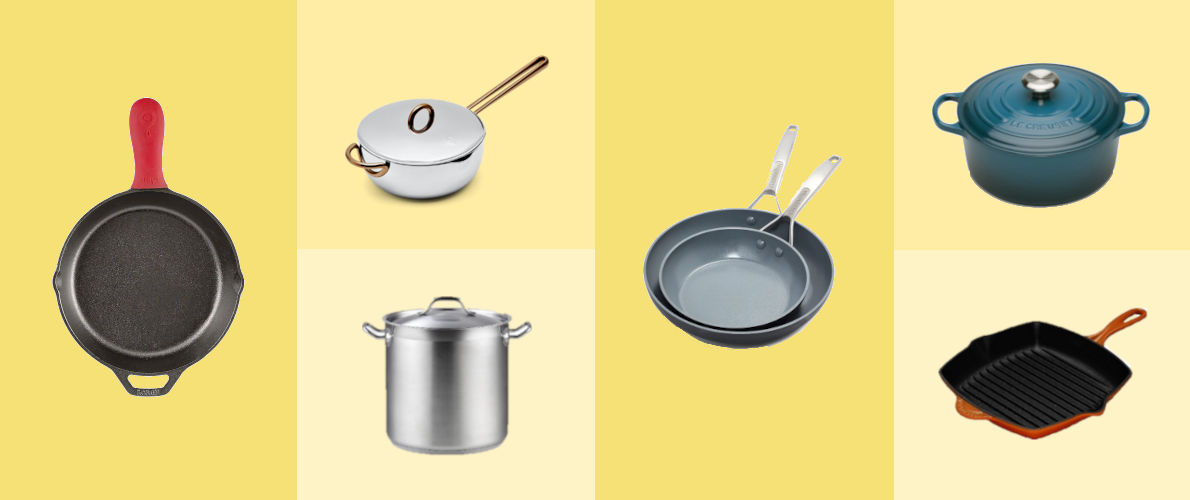
Whether you’re upgrading your cookware or setting your first kitchen or knowing nothing to start, buying new cookware is always a challenging task.
Where to start? Just back to basic because, finally, you’ll find that there’re some certain pots and pans that you’ll turn to the most. Some pieces might even hang by your stoves and have been heavily used almost every single day. For tiny kitchen dwellers, you might favor this fundamental cookware for a space-saving edition.
Ideally, we recommend rather buying only pots and pans you really need. While buying a set is usually more cost-efficient than individual pots and pans, but mixing and matching quality items in different material for various tasks are worthier and more versatile. Here're the fundamental pots and pans you’ll need for your perfect games:
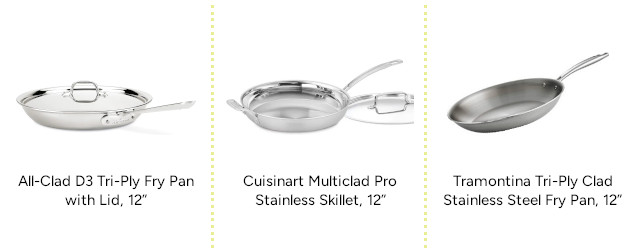
A decent stainless-steel skillet is the key to successful sear and sauté. To develop the perfect crusty fonds and make tasty pan sauces afterwards, a fully clad pan is ideal to even out temperature and avoid hot spots. The flared rim and low, sloped sides help quickly reducing moisture to create ‘sear not steam’ outcomes and pouring foods more conveniently.
Use it for: Universal tasks, like searing and browning large cuts of meat, sautéing vegetables, stir fries, roasting a whole chicken, pan sauces or cooking one-pan meals.
What to pick? Our best bet is All-Clad D3 Tri-Ply 12” Fry Pan with lid while Cuisinart MultiClad Pro 12” Skillet is a budget-friendlier pick. Also, Tramontina Tri-Ply 12” Fry Fan is an upheld choice but has no lid.
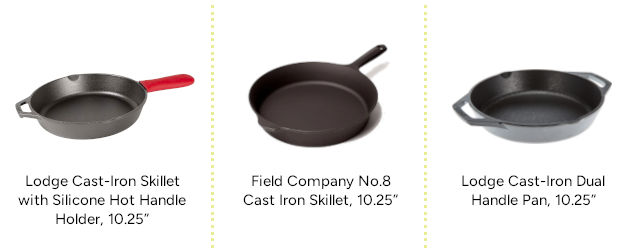
A cast iron skillet is a peerless player when you go for the intense heat that last so long. It gets better with age, lasts indestructibly a lifetime and is cheap. Only a big drawback is it needs appropriately care to prevent rust and corrosion. Don’t forget to buy the silicon handle holder to protect accidentally burns.
Use it for: Searing, sautéing and baking on every heat source — on the stove, in the oven, on the grill or even campfire. It splendidly giving deeply browned, crusty outcomes, from pan pizzas, pies, steaks to fried chickens.
What to pick? The 12’ size might be a favorite of many chefs, but we find it too heavy for daily basis. If you lucky enough, your grannies should have vintage ones, like Griswold. For new one, Lodge 10.25” Pre-Seasoned Skillet is unbeatable. Field Company No.8 is the lightest player here (only 4.5 pounds) but costs astronomically high.
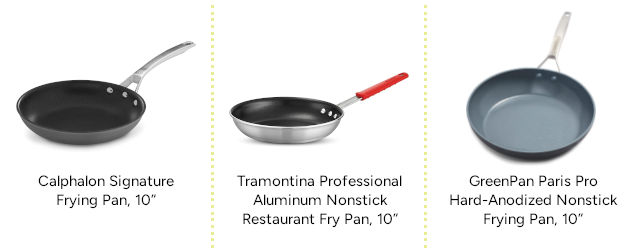
Every kitchen should have one or two nonstick pans due to the unparalleled convenience of handling the sticky foods and no-oil healthy dishes. Though quality coated pans these days don’t contain PFOAs and harmful toxins, some people feel safer for new alternatives, ceramic pans, which mostly have inferior nonstick power than traditional Teflon pans.
Use it for: Handling with sticky, wet foods, delicate protein or anything that is likely to adhere to the surface, like egg-based recipe, fish, crepes and cheesy dishes.
What to pick? We like Calphalon Signature 10” Skillet as the versatility of using on the stovetop and oven, as well as metal utensil-safe, while Tramontina 10” Professional Aluminum Nonstick Fry Pan is comfortably lightweight to maneuver. If you’re into ceramic cooking, consider GreenPan 10” Paris Pro Skillet.
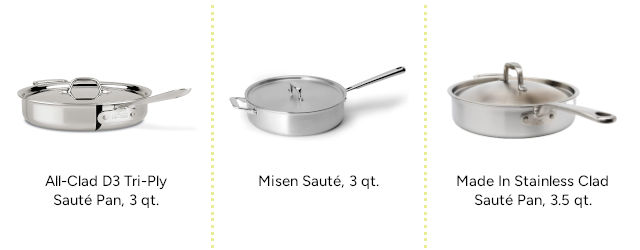
A good sauté pan should have a low L-shape sides — straight sides and wide flat bottom — thoughtfully designed for a spacious searing and sauteing without messy splashes out. Pick one that has a hefty tight-fitting lid for producing perfect braising and slow simmering. A wide helper handle can help transferring it from stovetop to oven smoothly.
Use it for: Producing recipes that are crispy, browned skin with juicy inside, sauce-based dishes or slow-paced cooking that work with a lot of liquid, such as simmering, braising and poaching.
What to pick? Our benchmark is All-Clad D3 Tri-Ply 3-quart Sauté Pan down to the superiority of heat ability, weight and design. Unlike skillets, since the heftier weight isn’t a big issue, 5-ply sauté pan is a great choice as giving gradual heating produces, not-drastic brown results and gentle braises. Made In 3.5-quart Sauté pan and Misen 3-quart Sauté are highly recommended.
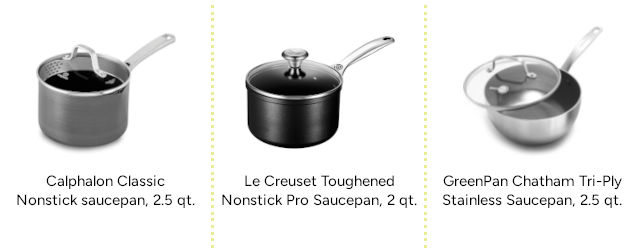
The small saucepan is incredibly useful for daily routines. For a peace of mind, we recommend a nonstick pot since you’ll often use it for reheating sauces, making soups or melting butter. So, stick-free surface lets you handle your tasks much easier and faster, without annoying sticks or burning scorches.
Use it for: Cooking a small batch of slow simmers, rolling boils and reducing liquids, from boiling eggs, melting butter and chocolate, reheating sauce to making a small-served soup and rice.
What to pick? Calphalon Classic Nonstick 2.5-quart Saucepan is good for daily basis and offers plenty of user-friendly designs. If you look for an extra-tough upgrade, look for Le Creuset Toughened Nonstick Pro 2-quart Saucepan. We also recommend GreenPan Chatham Tri-Ply Stainless 2.5-quart Saucepan for those who go to ceramic cooking.
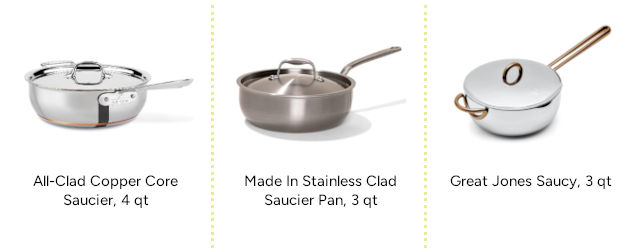
For this mid-size vessel, you can choose either a saucepan or saucier because both can fulfil nearly the same functions. After leaving the tacky tasks and reheating soups to a nonstick saucepan, we feel a saucier — a curved-bottom pot — is great to empower like-a-restaurant sauces. It sautés beautifully, whisks easily and reduces stocks efficiently, with no foods trapped in the edges.
Use it for: Saucier excels at sauces, stocks, and soups, especially for ones that need whisking and stirring, like risotto and saucy dishes. It’s also perfect for tossing the pasta and making jump sauté.
What to pick? Apart from price, All-Clad Copper Core 4-quart Saucier is a finest player here due to the ultimate thermal responsiveness and lightweight. Unfortunately, it’s hard to find and other excellence, G5, only has smaller size, so we go to Made In Stainless Clad 3-quart Saucier Pan. We also like this beauty, Great Jones 3-quart Saucy, as a reasonable performer with many favorable features: etched measurements, a pouring spout, a helper handle.
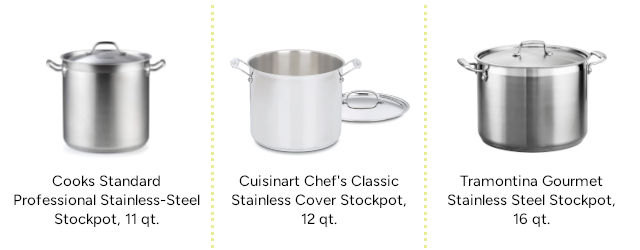
The large stockpot lets you cook larger number of things and feed a crowd versatilely. Stockpot doesn’t need searing/browning or long heat retention like a Dutch oven, so it should be narrow and tall for easy boiling, simmering or canning, if need. It doesn't need to be fully clad. A solid stainless-steel pot with a thick cladded bottom and strong handles is fine and saves more budget.
Use it for: Making a bone broth, cooking big batches of soups, boiling a party-sized pastas, simmering beans or even canning veggies.
What to pick? Our choices are Cuisinart Chef's Classic 12-quart Stockpot and a cheaper one, Cooks Standard Professional 11-quart Stainless Steel Stockpot. Consider Tramontina Gourmet 16-quart Stock Pot, if you plan to make extra-large foods that will foam-up like bean pastes.
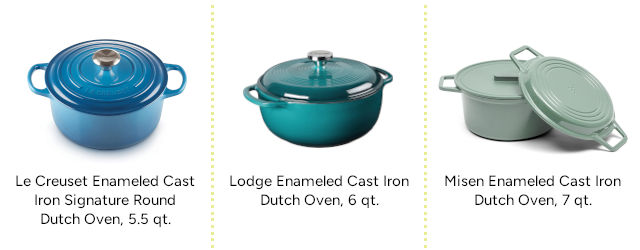
An enameled cast-iron Dutch (or French) oven or casserole is unbeatable for perfect braises, soups, stews and any low-and-slow cooking, as well as pot roasts and homemade breads. A good oven should have a wide bottom (for easier searing), thick tall walls and a heavy tight-fitting lid to trap moisture inside for producing more tender, juicier and tastier results.
Use it for: Great for making soups and stews, braising, slow cooking and steaming. Also, it’s apt for deep frying, baking and pot roasting.
What to pick? Le Creuset Enameled Cast Iron Signature 5.5-quart Round Dutch Oven is the reliable, worthwhile investment. Lodge 6-Enameled 6-quart Dutch Oven is a budget pick but heftier. We’re also impressed with the modern look and functionality of Misen Enameled 7-quat Dutch Oven that can transform a lid to a useful grill pan.
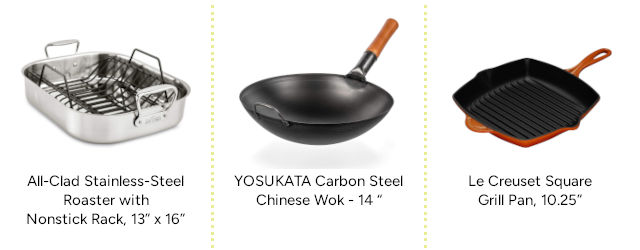
Keep in mind that you don’t need to buy all these pots and pans at once and can always add some items later. These’re extra pieces you might consider later: